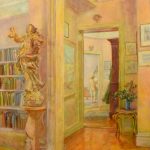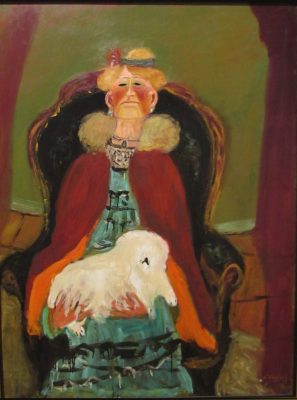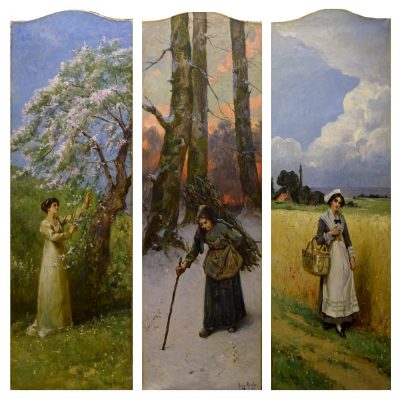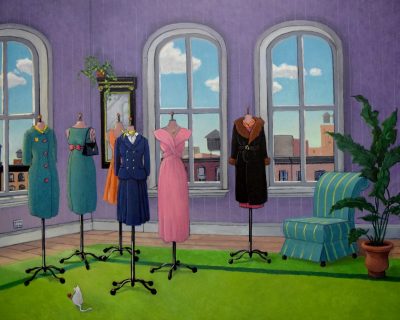April 3 – May 6, 2018
Opening Reception: Wednesday April 2018
5pm – 7:30pm
Free of charge and open to the public
Close Third Person highlights new work by the Studio Art MFA class of 2018. The exhibition features painting, drawing, printmaking, photography, ceramics, installation, and digital animation
The Master of Fine Arts in Studio Art program at the University of Connecticut is an intensive, multidisciplinary approach to the development of work in a wide range of media, including painting and drawing, photography and video, printmaking, sculpture and ceramics, and installation and performance. The three-year program focuses on the advancement of each student’s abilities as an artist. New graduate studio facilities in the historic Kirby Mill, situated on the banks of the Natchaug River, offer each student a fresh, well-lit space in a tranquil setting. Work in the studio and studio-based classes is combined with courses in art criticism, theory and history, and teaching to provide a context of ideas for developing students’ visions. Frequent contact with faculty members and visiting artists exposes the students to diverse viewpoints and practices. The Studio Art MFA program at UConn combines the creative excitement and intellectual energy of an art school and a major research university, providing students with the best of both worlds. Learn more at https://art.uconn.edu.
Artist Talks: Close Third Person
2018 Studio Art MFA candidates discuss their work.
Date: Wednesday, April 18, 3:00 to 5:00 pm.
Participating Artists:
Kelsey Miller
Statement
My art turned overtly political in January 2017 when I made letterpress signs for the Women’s March. Now the air is ever more clouded, fervent. Political opinion simmers continuously below the surface of the everyday and news advances at a rate faster than we can comprehend it. Belief, denial, complacency, and fear are emotional complexities that often seem at odds with scientific data. My work addresses the polarization of opinion and fact, informed by current events, archival documents, nationalism, and weather—a symbol of change and its real harbinger. The act of making resists the act of skimming, insisting that I absorb and respond to what has happened and is happening. My practice is a call to action, but also a pause, with the intention of offering a moment of reflection and sanctuary, in hope of finding better solutions for navigating this changing world.
Bio
Kelsey Miller was born on the island of Antigua and moved to the United States at the age of ten. She earned a BA in Studio Art from Wellesley College and spent four years as a chef on a sailboat before returning to land and pursuing her MFA at the University of Connecticut. Kelsey exhibits work nationally and internationally in solo, juried, and small group shows.
Jelena Prljević
Statement
As a storyteller, I use layering to build narratives. Using erasure, light, and the regenerative power of shadows I suggest time. Through process and material, my drawing serves as an invocation of place and reflects experiences of transition. Life is always in flux. Light and time give perspective, allowing change to unfold. Who defines whom? Does a final form exist or is its essence fluid? These questions are constant in my work. I champion the power of personal mark-making to build structures, erase them and build again to reveal life as it moves between light and shadow. My drawings and animations illuminate intimate observations grounding them in a present moment. Documentary, magical and sentimental, my work embraces the healing potential of storytelling through fragments of time, memory, and motion.
Bio
Jelena Prljević is an artist from Serbia whose practice exists within the intersection of drawing, animation, and installation. She holds a BFA from the Academy of Arts in Novi Sad, RS where she received several awards for painting and drawing. During this period, she participated in many national and international group exhibitions and collaborative projects. Jelena was awarded The Elizabeth Greenshields Foundation Grant to support the development of her MFA thesis project.
Kaleigh Rusgrove
Statement
Narrative photography exists between fact and fiction. I use my camera to create false moments of importance and to record artifacts of questionable authenticity. I interlace the seen with the contrived. Together these elements build a convincing story; one leaving the viewer unable to find their footing in either reality or fantasy. This body of work, this story, focuses on current environmental issues. Climate change falls into the same strange in-between where my work exists. The reality of the situation is distressing, the political response both alarming and laughable, and information presented is often contorted. Through research I find inspiration for image-making, combining what I have witnessed with what I have imagined. In my practice, I have come to learn that the most frightening moments are not always born from the wildness of the mind, but exist in real life.
Bio
Kaleigh Rusgrove was born in Bristol, Connecticut and spent her formative years photographing her younger sister against a leaf-patterned bed sheet with a Kodak disposable camera. Moving on to a point-and-shoot as a teenager, she made a series of portraits of local troublemakers that earned her moderate praise among the other neighborhood kids. Kaleigh eventually settled on the solitude of photographing herself with a DSLR. At some point she decided to keep making pictures forever.
Erin Koch Smith
Statement
My work often starts with something abstract—like a wayward emotion or a decontextualized word or phrase. I like language that feels vaporous and substantial, as if a dream sat on your head. Narrative is important as an impetus to painting, but my paintings are not stories. They are plotless, hero-less, scattershot moments, birthed from boredom, loneliness, and heartache, operating within the welcome limitations of the language of painting. On canvas, there are no rules for gravity, and floating objects can be heavy as lead. I search for form through scraping and damaging the surface, playing with images of swan beds, mangled chairs, and rainbows the way I used to play with Barbie dolls as a kid, bashing their plastic parts together, trying to land on something tender.
Bio
Erin Koch Smith was born in Richmond, VA where she fell in love with drawing and painting at an early age. Her studio practice encompasses a variety of approaches including painting, drawing, installation, and performance. She earned a BFA in Painting and Printmaking from Virginia Commonwealth University in 2005, and after living in Ithaca, NY for a number of years, relocated with her family to pursue an MFA in Art at the University of Connecticut.
Claire Stankus
Statement
Tidy piles of studio scraps, flowers on the floor, puzzle pieces, and birthday cakes are recurring features in my work. I collect seemingly banal and discarded objects and paint my daily encounters with them; expressing that even a pile of junk is worth painting. While some paintings are made directly from observation, others start from photographs of quickly-passed moments. I use casual marks, flattened fields of color, and invented line and shadow to break down the recognizable into something ambiguous yet familiar. The remaining abstraction is where we may find unexpected humor or joy. I want each painting to become something odd or sweet and give viewers a second chance to spend more time with an experience they may have overlooked.
Bio
Claire Stankus was born and raised in the suburbs of Albany, NY and earned a BFA in Painting from Syracuse University in 2012. She has attended artist residencies at the Chautauqua Institution, Vermont Studio Center, and Woodstock Byrdcliffe Guild. Claire was recently interviewed and featured on the podcast Studio Break.
Acknowledgements
We would like to express our gratitude to our families, friends, faculty, and peers who have provided continuous support and guidance over these three years.
We would also like to thank UConn’s Design Center for the creation of this catalog and accompanying materials.




